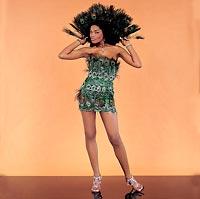Meet me at the Ebony Fashion Fair

Ebony Fashion Fair is a confluence of popular culture, racial uplift, community pride, tantalizing entertainment and good business.
The elaborate roadshow, which is in its 48th year and travels to 179 cities, celebrates style, glamour and the fervent belief that dressing up and dressing well are good for the soul. It raises money for local charities, especially those that focus on education.
Fashion Fair was developed by Eunice Johnson, who along with her husband, John, founded Johnson Publishing. John Johnson died in 2005, leaving a legacy that includes not only the fashion extravaganza and Ebony magazine, but also Jet magazine and Fashion Fair Cosmetics.
Their daughter, Linda Johnson Rice, is president and CEO of the Chicago company. And it falls to her to usher Ebony Fashion Fair into the future.
The fair has matured into a cultural institution that has raised more than $52 million for local and national charities.
But it is showing the effects of age. Its audience no longer is filled with the kind of young people who once vamped in their own designer duds, giving the show its heady aura. The show's arrival in a city no longer generates the anticipation it once did. How can it, when cable television now provides a steady loop of runway footage?
"We had the crème de la crème," says former model Audrey Smaltz, who was Fashion Fair's onstage commentator in the 1970s. "Sidney Poitier came to the show. Bill Cosby came to the show. Muhammad Ali came to the show."
Old-guard designer names — Givenchy, Bill Blass, Thierry Mugler — dominate this year's show, titled "Fit to Be Fabulous." Big-buzz labels such as Marc Jacobs, Balenciaga and Prada are scarce.
"We have to reach out to younger audiences. They need to see how they can see themselves as black women," Rice says. "Here is a show showcasing everything about African-American women that is positive."
Rice also is interested in incorporating brands spawned by hip-hop, such as Sean John, Rocawear and Baby Phat. "I just have to look to see if it's appropriate for us," Rice says. "We're not trying to push the real provocative edge."
A history of giving
Fashion Fair was conceived in 1956 when the wife of Dillard University's president asked John Johnson to sponsor a fundraising fashion show for New Orleans' Flint-Goodrich Hospital, which served black patients. That show's success led to the traveling production that exists today.
Wherever Ebony Fashion Fair stops, it is at the behest of a local charitable organization. "We look for those types of organizations with a track record for fundraising and also with the same philosophy: uplift," Rice says.
Ebony provides the packaged production. The local group pays for the venue, houses the models and gives them a per diem. Volunteers sell the tickets. The local organizers receive a percentage.
An impressive collection
Fashion Fair clothes are always among the most lavish — and expensive — in a designer's collection. Johnson Publishing purchases them all, rather than borrowing them, which is the norm. In part, this grew out of a legacy of racial discrimination. Designers "wouldn't let us in," Smaltz recalls. "They wouldn't give us an invitation to the show."
Johnson would spend thousands of dollars with a single designer. "I have a check she wrote to Valentino for $50,000," says Smaltz, who with her extroverted personality and imposing height would do her best to myth-make on behalf of her employer. "People would ask me, 'What is Mrs. Johnson's first name?' I'd say, 'Missus.' "
The tradition of paying for the clothes continues because "we don't want to be beholden to anyone," Rice says. The company has a clothing budget of more than $1 million and an archive of garments dating to the 1950s.
"We're going to start to catalogue them. We've tried to keep that sort of quiet," Rice says. "They are really exceptional, one-of-a-kind pieces."
The show defined fashion on its own terms — in plus-sizes, with church hats, with finger-paint colors when black was all the rage. It was among the first to bring labels such as Fendi, Pucci and Roberto Cavalli to the American public. It showed the industry that black women could command a runway. It introduced generations of black women to fashion at its most extreme, planting the seed for today's desire for "it" bags, designer shoes and king's-ransom jewelry. It fed a hunger to be perceived as glamorous and beautiful. Fashion Fair made an impact.
The ripple effect, however, has been slow and almost imperceptible.
"I'm not so sure we've influenced the general market," Rice says. "But I'm not sure we're trying to do that."






Coming up
The Ebony Fashion Fair will make four stops in Washington this year.
• 7 p.m. April 22, New Mount Tahoma High School, 4634 South 74th St., Tacoma. Tickets: $30. Information: 253-383-2007. A benefit for the Tacoma Urban League.
• 4 p.m. April 23, Doubletree Hotel Seattle Airport, 18740 Pacific Highway S., Seattle. Tickets: $75 (2 p.m. dinner). Information: 253-838-6816 or 425-430-1504. A benefit for the Bethune Legacy Scholarship Award.
• 8 p.m. April 25, Northern Quest Casino, Pend Oreille Pavilion, 100 N. Hayford Road, Airway Heights. Tickets: $45 (7 p.m. dinner). Information: 509-534-9071. A benefit for civic activities sponsored by the SpokanE chapter of Links Inc.
• 7 p.m. April 26, Three Rivers Convention Center, 7016 W. Grandridge Blvd., Kennewick. Tickets $35. Information 509-967-2902. A benefit for LINKS Programs.
More information: www.ebonyfashionfair.com